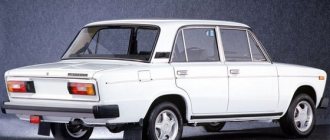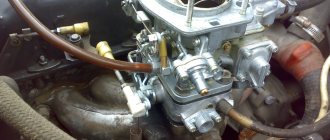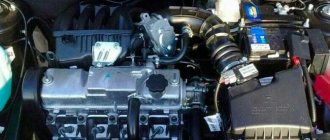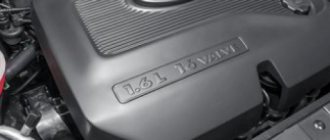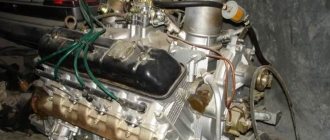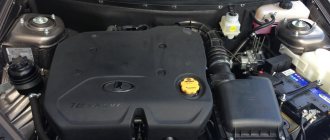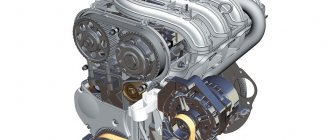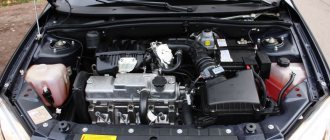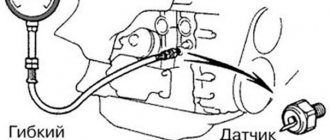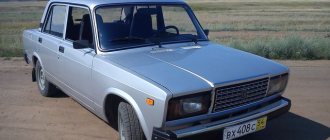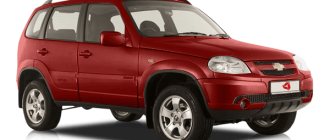An interesting solution from Soviet manufacturers was the VAZ 21067 engine, which was a slightly modified version of its predecessor. This power unit produced up to 82 horsepower at 5600 engine rpm. Peak torque was reached at 3500 rpm and amounted to 122 Nm.
The VAZ 21067 engine injector has become interesting for buyers, since its power system has been completely revised. Now, the ill-fated carburetor, which caused a huge number of problems, was no longer necessary.
Specifications
| Engine capacity, cc | 1568 |
| Maximum power, hp | 74 — 82 |
| Maximum torque, N*m (kg*m) at rpm. | 116 (12) / 3000 116 (12) / 3650 122 (12) / 3500 |
| Fuel used | Gasoline AI-95 Gasoline AI-92 |
| Fuel consumption, l/100 km | 8.8 — 9.8 |
| engine's type | In-line, 4-cylinder |
| Add. engine information | Injector |
| Maximum power, hp (kW) at rpm | 74 (54) / 5300 75 (55) / 5400 82 (60) / 5600 |
| Number of valves per cylinder | 2 |
Main differences from LADA 2105
- More powerful 1.5 liter engine. and a power of 77 horsepower (for carburetor versions);
- A modified, often chrome-plated radiator grille with a larger area (in the last years of production, the LADA-2104 was equipped with the same ones for unification purposes);
- The structure of the rear lights has been slightly changed (5-section instead of 6-section in 2105);
- More comfortable front seats with integrated headrests (in the last years of production, LADA 2105, 2104 were equipped with the same ones for unification purposes);
- Some of the cars produced were equipped with a rigidly molded interior headliner and plastic ventilation linings for the rear pillars;
- Modernized front instrument panel (in particular, a tachometer and speedometer with digitization up to 180 km/h were added, as well as an oil pressure indicator (until 1988, after which it was replaced by an econometer);
- Added cold air deflectors (“torpedo”) located in the center. While a stream of hot air can be directed to your feet (through the cabin heater), through these deflectors you can direct a stream of cold air to your face (only at speed, using the pressure of the oncoming air flow);
- Plastic bumpers with chrome trims instead of more massive aluminum ones. In recent years of production, LADA 2105, 2104 were equipped with the same ones for the purpose of unification and reduction in cost;
- Changed shape of the hood (in the last years of production, the LADA 2104 was equipped with the same ones for unification purposes);
- Slightly changed shape of the trunk lid (without stampings), since 2008 they began to install a trunk lid with stampings, like the VAZ 2105, due to the unification of production;
- Some interior details have been changed: door upholstery, door lock buttons, radio panel (“beard”), gearshift knob, steering wheel shape (which later became uniform due to unification);
- The electrical system circuit differs (there are also differences between individual modifications depending on the type of engine).
Peculiarities
The technical characteristics of the VAZ 21067 engine were obtained thanks to the fact that engineers refined and improved the 2106 model. First of all, the power system of the power unit, which provided for distributed fuel injection, was improved. In this particular case, the system from the 2104 engine was used, which had previously shown itself to be quite good.
The power unit turned out to be quite powerful due to the fact that it is equipped with four cylinders, which together give a working volume of 1570 cubic centimeters. At the same time, the manufacturers managed to achieve a weight of only 121 kilograms.
The VAZ 21067 block, like its predecessor, was created on the basis of an earlier model of the VAZ 2103 engine. The main change was that the diameter of each cylinder became reduced, which led to a power of 74.5 horsepower. But this solution, in combination with an increase in the piston stroke, made it possible to achieve maximum performance at engine speeds of 5400.
The alterations led to the appearance of a new model of the power unit. Among other things, the engine began to be equipped with a modified cylinder head gasket made from higher quality materials.
The VAZ 21067 engine number is located the same as on its predecessor model. Everything here is classic for domestic solutions - the panel with markings is located on the lower air supply box.
Description
The VAZ 21067 engine is compatible for installation on VAZ 2103/6/21/053/07 car models
Model 21067 has been modified and improved from model 2106. These improvements have been made to the power system, which features distributed fuel injection. In this case, they are used exactly as on the 2104 engine.
Euro 2 standards - absolute compliance
This engine is quite powerful, equipped with four cylinders, each of which has a volume of 1.57 liters and a diameter of about eight centimeters, and the engine weighs one hundred and twenty-one kilograms.
Based on the earlier model VAZ 2103, they created the VAZ 2106 . It is precisely due to the fact that the diameter of each cylinder was made larger, its power, accordingly, became 74.5 horsepower, and the speed at which the crankshaft rotates is 5,400 rpm. Based on the alterations described above, a new cylinder block appeared in the new engine model, its model 2106 - 1002011. In addition, an already modified gasket on the block was used in the improved product.
Characteristics and properties
| Start of production | 1976 |
| Block material | cast iron composition |
| Diet | injection |
| Type | in-line |
| Availability of cylinders | 4 pieces |
| Availability of valves | 2 pieces per cylinder |
| Piston stroke | 80 millimeters |
| Cylinder diameter | 79 millimeters |
| Compression level | 8.5 |
| Motor capacity | 2106 7 1.569 cubic meters |
| Motor power | 75 horsepower and 5,400 rpm |
| Engine torque | 116 Nm or 3000 rpm |
| Suitable fuel type | AI 92 |
| Gasoline consumption | 0.3 liters in the city; 7.4 on the highway; 10 liters on a mixed type of road - per 100 kilometers |
| Engine oil consumption | 0.7 liters per 1,000 kilometers |
| Dimensions of the motor 21 067 (length x width x height) in centimeters | 56.5 x 54.1 x 66.5 |
| Product weight | 121 kilograms |
Types of oils that are suitable for motor 21067: 5 W - 30/40; 10 W - 40; 15 W - 40. The volume of oil that fits into the 21067 engine is 3.75 liters.
Peculiarities
Pistons of this engine The pistons imitate the 21011 model. In this type of pistons, the well is made in the shape of a cylinder, and the stroke of one is 8 cm. The piston design of this type has a cylindrical well. Its stroke is 8 centimeters. When the piston is used in the operation of the engine, different parts of it warm up at different rates. It is for this reason that its shape is slightly different from that of a regular cylinder. And this helps ensure that the subsequent heat and deformation are compensated. For the same purposes, certain thermal control plates, which are made of high-strength steel, are located in the piston bosses.
The hole made for the small piston is deliberately made with a deviation from the central axis. This was done specifically to reduce the level of permissible loads as much as possible. And near such a hole there is a special designation - “P”, which serves as an indicator for the correct assembly process. After all, upon completion of the work done, such indicators should be directed to the front part of the cylinder block. As for the rings in the pistons, they are of a standard size, their material is chrome-plated cast iron, which has a beneficial effect on their long period of operation. There are some configuration options when such rings are made of steel.
In this engine model, the crankshaft is made the same as in the VAZ 2103. The generator of the model is installed - G 221. The starter is 1300 Watt, model 35, 3708. Everything else is exactly the same as in the 2103 model.
Advantages
The engine has been sufficiently redesigned, so in comparison with its predecessors it has received a large number of advantages. But most of them turned out to be classic for domestic models:
- The design and repair of the VAZ 21067 engine still remained quite simple, so its suitability for repair is very high. You can purchase any parts in almost all stores, and even major repairs can be carried out in an ordinary garage without any problems.
- An injector appeared in the engine. The VAZ 21067 injection engine, unlike its predecessors, did not require constant monitoring in the form of ignition settings, adjustment of jets and their cleaning. The use of such a power system made it possible to slightly reduce consumption and also achieve stable operation.
- The VAZ 21067 January 7.2 ECU has appeared, which can be diagnosed without any problems using the k-line adapter VAG. But at the moment, friends from the Middle Kingdom have made ELM, which can easily cope with the assigned tasks on almost all VAZ models.
Sensors VAZ 2107
Introduction
VAZ 2107 is the brainchild of the domestic AvtoVAZ. The production of this car ended almost 10 years ago, but the car was produced for quite a long time, since 1982, and even managed to travel around the USSR. At the end of the 20th century, a carburetor engine was installed on the “seven”, but the “zero” VAZ 2107 received an engine with electronic fuel injection, that is, an injector.
Most cars that have survived to this day can be found with an injection engine. As you know, for the correct operation of an engine with electronic fuel injection, many sensors are used. This article describes all the sensors of the VAZ 2107 car, their location is indicated, as well as signs of a malfunction.
Problems
But the VAZ 21067 internal combustion engine is famous not only for its advantages, but also for its disadvantages, which are generally characteristic of most power units from domestic manufacturers. These are classic problems, the main ones being:
- There are no hydraulic compensators, which requires frequent adjustment of the thermal clearances of the valves (every 10 thousand kilometers). As a rule, a signal for the need for this procedure is engine noise.
- The camshaft wears out very quickly. This is due to a flaw in the design of the lubrication system, so the camshaft is the weakest point in the engine. At idle, the required oil pressure is absent, which is very noticeable. In order for the engine to have a longer service life, it is necessary to fill only high-quality oil and also change it in accordance with the regulations.
- The cooling system remains from the old engine. This is a serious problem because fuel injected engines have a leaner mixture, which causes the engine to run hotter. Therefore, while moving when it is warm outside, the cooling system fan starts working very often. This entails that the fan bearing quickly fails.
- Big expense. Despite all attempts by domestic engineers to reduce these indicators, the old design made its presence felt. In winter, the engine can consume up to 15 liters of gasoline per 100 kilometers.
- Problems with attachments. Although the motor itself has a fairly long service life, the attachments are not of particular quality, so they often create problems.
- The brains of the VAZ 21067 can simply burn out. This is a common problem, especially for the first engines, since manufacturers were just testing the design of the electronic control unit on them.
Which gasoline is better to fill in - AI-92 or 95?
Which gasoline to prefer: 92 or 95 is a traditional topic of discussion among car enthusiasts. And although the operating instructions for each car indicate the permissible class of gasoline, debates about the advantages of one or another brand of fuel do not subside. Perhaps also because in modern cars the manufacturer indicates a threshold or range of octane numbers.
Besides price, what are the main differences between 92 gasoline and 95 gasoline? What kind of gasoline should be poured at a gas station if the use of fuel, for example, with an octane number of at least 92 is allowed? Is it possible to mix brands of gasoline and fill in 92nd if the manufacturer recommends 95th? All these questions are constantly of interest to the car enthusiast community.
Be sure to watch the video at the end of the article, in which the technical characteristics of a car were compared in laboratory conditions, the tank of which was alternately filled with 95 and 92 gasoline.
You may also be interested in our material on which oil is best to pour into a car engine.
Quality, octane number and other characteristics and properties of gasoline
The main characteristics of the gasoline brands used in Russia are given in the table above. The sacred series of numbers 92, 95, 98 denotes what in technology is usually called octane numbers. To put it simply, these are quantitative indicators of the fuel’s resistance to detonation (self-ignition and subsequent explosion) during compression.
The higher the octane number, the higher the detonation threshold, which means the constant use of 92-grade gasoline in engines designed for 95-grade gasoline can lead to undesirable consequences from detonation phenomena (especially when operating at high speeds).
Octane number is the most important characteristic of a gasoline brand for a consumer. But the properties of the fuel are not limited to this and are largely determined by the technology for producing gasoline during the refining of petroleum products.
The fact is that gasoline obtained after direct distillation of oil has a low octane number - no more than 60. Further, various methods can be used to increase the octane number in the technological chain. In Russia, the most common technology is catalytic cracking (another name is hydrocracking), which brings the octane number to 85.
The next stage of increasing the octane number is the use of additives:
- The first type of additives – metal-containing additives based on lead compounds – was widely used in the last century in the USSR (the final product was leaded gasoline). Such additives worked very effectively, but caused harmful emissions into the environment and for this reason are completely prohibited for use.
- Additives containing manganese or iron compounds (ferrocenes) have proven to be less hazardous to the environment. But their use is also limited: manganese compounds decompose in light (the consequence is deterioration of resistance to detonation) and ferrocenes (a source of oxides) are one of the causes of soot formation. In addition, ferrocenes contribute to the formation of resins that pollute the engine.
- Taking into account environmental requirements, additives based on ethers and alcohols are considered the most effective. However, such compounds have a relatively low octane number - 120 (for comparison, in metal-containing additives this figure reaches 280). Therefore, the specific content of such additives in gasoline should be high – up to 15%. The main disadvantage of ether and alcohol additives is their high volatility, which means that the fuel is not intended for long-term storage and must be “fresh”.
Maintenance
The engine needs to be serviced in the same way as other models of classic power units. Everything here is quite simple, so most owners do not encounter problems. For correct operation, you need to change the timing belt every 40 thousand mileage.
The lubricating fluid must be replaced every 10 thousand kilometers. The block is designed to hold 3.75 liters, but during replacement, some of the old grease remains inside, so it is recommended to fill only 3.5 liters there.
Gasoline and air filters are regulated to be replaced every 20 thousand kilometers. But here it is already necessary to look at the operating conditions, because if the engine operates in rural areas where there is a lot of dust, then the period for replacing the air filter element is significantly reduced.
The valves are adjusted after a run of 10 thousand kilometers. But as practice shows, this period can be significantly reduced if poor fuel or low-quality lubricants are used.
Is it possible to operate an IZH motorcycle on 92 gasoline?
Classic motorcycles are already on their way out. Finding similar motorcycles is now a problem. At the same time, young people who have received similar equipment by inheritance or other means ask whether an IZH motorcycle can be operated on 92 gasoline, without consequences for the piston engine. We will deal with this.
- Generations of IZH motorcycles
- What kind of gasoline to pour into an IZH motorcycle?
- Manufacturer's recommendations
- What do experts advise?
- Video
- Bottom line
Generations of IZH motorcycles
The manufacturer has a range of equipment, different years of manufacture and modifications. At the same time, the bikes were equipped with different engines, separated by the type of fuel consumed.
The manufacturer's assortment includes models such as Jupiter and Planet of various modifications.
What kind of gasoline to pour into an IZH motorcycle?
At domestic gas stations in 2022, it will be problematic to find gasoline grades lower than AI-92. Consequently, it is unknown where drivers of vehicles that consume fuel like AI 80 or 76 should go.
Here we will begin to figure out what to do in such a situation.
Manufacturer's recommendations
Each motor is designed for a specific type of fuel and lubricants. Specifically, you can see what kind of fuel needs to be poured on the inside of the gas tank cap. On Planet 2/3 versions, this is fuel with an octane rating of 73-76. In this case, even eighty gasoline will be perceived incorrectly.
For Planets 4 and 5, the plant recommends using AI-80 gasoline. For the most recent versions, type 92 was also standard.
If the power plant is fed with fuel with a higher octane number, this can lead to consequences.
- Rapid overheating of the power plant.
- The appearance of detonation.
- Violation of the temperature regime of engine operation.
- Burnout of valves.
- Damage to the piston group.
What do experts advise?
Experienced motorcyclists advise not to rush to retire the equipment, but to use some tricks.
Even if the equipment is not designed to fill high-octane fuel, you can try adding more oil to the fuel. An abundance of lubricant will stabilize combustion and prevent early ignition. You should also reconfigure the ignition and change the timing to a later trigger.
This approach will prevent the valves from burning out and will protect the power plant from overheating.
In any case, the best solution would be to fill with the cheapest gasoline found at the gas station. You can no longer find the recommended fuel at gas stations, so you need to proceed from the situation.
Modifications
VAZ engineers did their best when they developed this power unit, but they did not stop there, so they constantly refined it. Since then, two engine modifications have appeared:
- VAZ-21067-10 is a special modification of the power unit, which was developed specifically for the VAZ 21074-20 model. The main differences from the standard model were the reduction in displacement to 1451 cubic centimeters. The engine power reached 71 horsepower, and the torque was 112 Nm.
- VAZ-21067-20 - the power of this engine is 74 horsepower and the torque is 120 Nm, and it was developed specifically for installation on the VAZ 21074-30 car. The changes affected the cylinder diameter, which was now 82 millimeters, and the piston stroke was 75 millimeters. The key difference between the engine was cleaner exhaust, which complied with the Euro 3 standard.
Engine for VAZ-21067, 2104, 2105, 21053, 2107 (injector) buy new
Buy new VAZ-21067 engine
For VAZ 2104-2107
Engine assembly
The engine plus everything that is attached to it: a generator with a mount (bracket), a distributor (if any), a carburetor, a fuel pump (if a carburetor), coils and wires, intake and exhaust manifolds (on the carburetor).
On the injector: receiver, intake and exhaust manifold (catalog manifold), throttle valve (if injector), all rubber hoses, all small brackets, all belts: generator, toothed, on classic engines: - chain. Dipstick
Break-in oil (10v40 semi-synthetic Lukoil, recommended after running in 1000-1500 km, oil change).
On the injector: a ramp with injectors and injector wiring; on a 16-valve engine, the kit includes 4 ignition coils with a wiring harness.
Packaging: everything is mounted on a wooden stable pallet, screwed on, the engine itself is made of cardboard on all sides and wrapped with stretch film. The transport company is packed in a wooden box.
Cost of VAZ 21067 engine injector
- Cylinder block assembled with piston group and crankshaft - 42,000 rubles.
- Cylinder block assembly, cylinder head assembly, without attachments - RUB 74,000.
- Engine assembled with attachments - 94,000 rubles.
We ship with a 10% prepayment throughout Russia! If you are at a loss with a choice, then write to our manager in the chat or request a call back
Have you watched recently
We deliver throughout Russia and Kazakhstan by transport companies
List of delivery cities
Abakan Adler Almetyevsk Angarsk Apatity Arzamas Armavir Arkhangelsk Asbest Astrakhan Achinsk Balakovo Balashikha Barnaul Belgorod Beloretsk Berdsk Berezniki Biysk Blagoveshchensk Borisoglebsk Borovichi Bratsk Bryansk Buzuluk Velikiye Luki Veliky Novgorod Vladivostok Vladikavkaz Vladimir Volgograd Volgodonsk Volzhsky V ologda Vorkuta Voronezh Voskresensk Votkinsk Vsevolozhsk Vyborg Gatchina Glazov Gorelovo Grozny Dzerzhinsk Dimitrovgrad Dmitrov Domodedovo Yeysk Ekaterinburg Zheleznodorozhny Zabaikalsk Zelenograd Zlatoust Ivanovo Izhevsk Irkutsk Yoshkar-Ola Kazan Kaliningrad Kaluga Kamensk-Uralsky Kamensk-Shakhtinsky Kamyshin Kachkanar Kemerovo Kerch Kirov Kirovo-Chepetsk Klin Klintsy Kovrov Kolomna Kolpino Komsomolsk-on-Amur Kostroma Kotlas Krasnogorsk Krasno dar Krasnokamsk Krasnoyarsk Kuznetsk Kumertau Kurgan Kursk Leninsk -Kuznetsky Livny Lipetsk Magnitogorsk Maykop Makhachkala Miass Moscow Murmansk Murom Mytishchi Naberezhnye Chelny Naro-Fominsk Neftekamsk Nizhnevartovsk Nizhnekamsk Nizhny Novgorod Nizhny Tagil Novokuznetsk Novomoskovsk Novorossiysk Novosibirsk Novocheboksarsk Novocherkassk Novy Urengoy Noginsk Noyabrsk Obninsk Odintsovo Oktyabrsky Omsk Orel Orenburg Orekhovo-Zuevo Orsk Penza Pervouralsk Perm Petrozavodsk Podolsk Pskov Pushkin Pushkino Pyatigorsk Roslavl Rossosh Rostov-on-Don Rybinsk Ryazan Salavat Samara St. Petersburg Saransk Saratov Sevastopol Severodvinsk Sergiev Posad Serov Serpukhov Simferopol Smolensk Solnechnogorsk Sosnovy Bor Sochi Stavropol Stary Oskol Sterlitamak Stupino Surgut Syzran Syktyvkar Taganrog Tambov Tver Tobolsk Togliatti Tomilino Tomsk Tula Tyumen Ulan- Ude Ulyanovsk Usinsk Ussuriysk Ust-Kut Ufa Ukhta Khabarovsk Khanty-Mansiysk Tchaikovsky Cheboksary Chelyabinsk Cherepovets Chekhov Chita Mines Sheremetyevo Engels Yaroslavl
Tuning
In this aspect, the engine turned out to be quite interesting, since there are a lot of options for its modifications in garage conditions. The classic planning of the cylinder head by just a millimeter to raise the compression ratio in combination with the removal of the catalyst allows to reduce consumption and also increase its maximum power. You just have to contact specialists to install new software on the control unit. But on such an engine it is already recommended to use 95 gasoline. With such solutions, while driving along the highway at an average speed of 100 kilometers per hour, the engine consumes about 7 liters.
In motorsport
- This car is very popular in Hungary, where it has long become a cult car, and is widely used in motorsport (mainly in rallies);
- 2006—2010. Russian Classic Rally Championship - Grigory Novichikhin;
- 2010—2011. Russian Circuit Racing Championship (RTCC) - No. 77 Vladislav Kubasov, Team: VPK SPORT;
- 2012. BATTLE ROBOT CAR competition in Astrakhan, in which the VAZ 2107 was equipped with a remote control.
- Previous post
- Next entry
Chassis, steering and braking system
The front suspension of the VAZ 2107 has an independent double wishbone design with two shock absorbers and springs, as well as a stabilizer bar. The rear suspension is dependent with a rigid beam, which is connected to the body through one transverse and 4 longitudinal reaction rods. The suspension design is complemented by two hydraulic shock absorbers with coil springs.
wheels - 5Jxl3H2 (permissible offset 25-30 mm);
tires - 175/70R13 (165/70R13).
The steering mechanism of the VAZ 2107 is a globoidal “worm” driven by a double-ridge roller (gear ratio 16.4). Drive – three-link (2 lateral symmetrical rods, middle symmetrical rod, pendulum arm, swing arm, bipod).
The VAZ 2107 brake system has a foot (foot) drive through a vacuum booster. Its design also includes an emergency sensor and a brake fluid pressure regulator in the rear wheel drive. The parking (hand) brake is activated by a cable that engages the rear wheel chocks. The rear wheels are equipped with a drum-type brake mechanism.
The brake mechanism of the front wheels has a classic disc design with automatic clearance adjustment.
How is 21074 different?
The main and, perhaps, the only difference from the beds of other sevens of various modifications is in the engine. This is a 1.6-liter (more precisely, 1,569 cc) engine with a cast-iron Fiat block and an aluminum head. Initially, the engine ran only on 93-octane gasoline, but later the compression ratio was lowered to allow the vehicle to be operated on lower grades of fuel. Since the power system still remained carburetor, there was not much difference. The seven happily consumed about 10 liters of fuel in mixed mode.
Seventy-five power and 116 Nm of torque look helpless by modern standards, but then for the country that built communism, it was proletarian chic. Even the Volga was more powerful by only a dozen forces. Toward the end of its career, 21074 still received distributed injection, although it was a different modification, 21074-10, which met Euro2 standards, and the next year an even more advanced seven 21074-20 with an injector appeared, which could meet Euro3 standards. But the injection versions of the six engine completely abandoned 92 gasoline and required only high-octane 95 gasoline.

